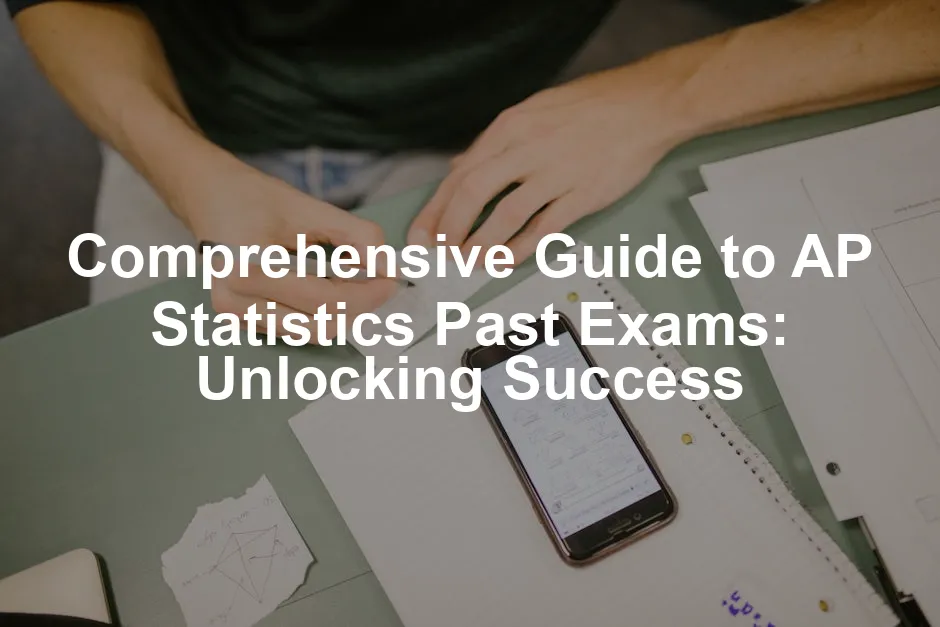Introduction
Preparing for the AP Statistics exam can feel like a daunting task. However, understanding past exams can be a game-changer. Why? Because they provide invaluable insights into the exam structure, question types, and scoring. Grasping these aspects can give students a significant edge in their preparation.
This article serves as a comprehensive guide to AP Statistics past exams, aimed at helping students navigate their study strategies effectively. Readers can expect a detailed breakdown of resources, methods to utilize past exams, and actionable tips for exam day success.
Whether you’re a student gearing up for the big day, a teacher seeking effective materials to help your class, or a parent wanting to support your child’s preparation, this article is for you. It’s designed to equip everyone involved with the knowledge needed to tackle the AP Statistics exam confidently.
So, grab your favorite snack, settle in, and let’s get this statistical party started!
Understanding the AP Statistics Exam
Exam Structure
The AP Statistics exam consists of two primary sections: Multiple Choice and Free Response. Each section is crucial to understanding your overall performance.
Multiple Choice Section: This section includes 40 questions and accounts for 50% of your total score. You’ll have 90 minutes to complete it. Questions may be standalone or grouped around a common theme.
Free Response Section: The free-response section consists of 6 questions, also contributing 50% to your overall score. You’ll have 90 minutes to tackle them. This section is further divided into two parts. Part A contains four questions focused on data collection, data exploration, probability, and inference. Part B features one investigative task that assesses multiple skills in a real-world context.
To help you ace these questions, consider investing in a Graphing Calculator (TI-84 Plus CE). This powerful tool will assist you in solving complex statistical problems quickly, giving you more time to focus on the concepts rather than calculations.

Scoring Breakdown
Understanding how your exam is scored is vital. Each section contributes equally to your final score, but the nuances matter. For instance, the multiple-choice section rewards quick thinking and accuracy. In contrast, the free-response section tests your ability to articulate statistical reasoning and methodology. Strive to master both sections for a balanced preparation.
By comprehending the exam structure and scoring, you can tailor your study plan effectively. Focus on practice questions from both sections to build familiarity with the exam format. Remember, practice makes perfect, especially when it comes to statistics!
In the next sections, we’ll explore how to make the most of past exams, where to find resources, and strategies for success. With the right tools and approach, you can conquer the AP Statistics exam like a pro!
Importance of the Exam
College Credit Opportunities
Scoring well on the AP Statistics exam can lead to college credit. Many colleges and universities grant credit for scores of 3 or higher, depending on their policies. This credit can save you time and money in college. Imagine entering college with credits already under your belt! This could mean skipping introductory courses and diving straight into advanced classes. You’ll impress your classmates with your statistical prowess while enjoying a lighter course load. Plus, it looks fantastic on your college applications.
Skills Assessed
The AP Statistics exam isn’t just a test; it’s a showcase of your critical thinking and analytical skills. These skills are essential, not just for passing the exam but for life! You’ll learn to interpret data, assess variability, and understand the principles of probability. These abilities are vital in today’s data-driven world.
As you tackle real-world problems, you’ll learn to make data-informed decisions. This type of thinking translates well into various fields, from business to science and beyond. So, while you might think of the exam as a hurdle, it’s really a stepping stone to developing skills that will serve you well in the future.
To enhance your study sessions, consider grabbing a pair of Noise-Canceling Headphones. They can help you focus by eliminating distractions, making your study time much more productive.

Utilizing Past Exams Effectively
Where to Find Past Exams
Finding past AP Statistics exams is easier than you might think. Several excellent resources can help you get started.
Official Resources
The College Board, the organization behind AP exams, offers a treasure trove of official past exams. You can access free-response questions and scoring guidelines directly on their site. For a comprehensive list of past exam questions, check out their official page here. This resource includes sample responses and commentary from exam readers, giving you insight into what graders look for.
Unofficial Resources
In addition to the official site, there are various unofficial resources that can be equally beneficial. Websites like MyMathsCloud provide access to a plethora of past papers from 1997 to 2023. You can find not just the exams but also marking schemes that can aid your study.
Another great site is PrepScholar. They compile every available practice test, including guidance on how to use them effectively.
Finally, consider checking platforms like Stat Trek and Varsity Tutors for additional practice questions and diagnostic tests tailored to AP Statistics.
By utilizing both official and unofficial resources, you can create a well-rounded study plan that covers all bases.

Types of Past Exam Questions
Free-Response Questions: These questions hold significant weight in the AP Statistics exam. They require students to show their understanding of statistical concepts and apply their knowledge to real-world scenarios. To tackle these, read each question carefully. Break down complex problems into manageable parts. Start by identifying what the question asks. Then, outline your response before diving into calculations. Showing your work is crucial; it can earn partial credit even if your final answer is wrong. Practice makes perfect, so review past free-response questions and try to replicate the thought process.
Multiple-Choice Questions: Multiple-choice questions can feel like a game of chance, but strategy is key! Familiarize yourself with the format. Read each question thoroughly before looking at the options. Eliminate obvious wrong answers first. This increases your chances if you need to guess. Time management is vital here. Don’t dwell on tough questions; flag them and move on. You can return later if time permits. Regular practice with multiple-choice questions from past exams will help you recognize common patterns and question types.
Strategies for Using Past Exams
Practice Exams: Simulating test conditions is essential for success. Use past exams to create a realistic testing environment. Set a timer for each section and refrain from any outside help. Treat it like the real deal! This practice builds endurance and helps you manage stress. After completing a practice exam, review your answers thoroughly. Understanding where you went wrong is just as important as knowing what you got right.
Reviewing Scoring Guidelines: Familiarize yourself with the scoring guidelines provided by the College Board. These guidelines show what graders expect in responses, particularly for free-response questions. Knowing these criteria can help you craft better answers. Look for sample responses that received high scores. Analyze their structure, clarity, and the depth of explanation. This insight can enhance your writing and problem-solving skills.
Analyzing Past Performance: Self-assessment is a powerful tool. After taking practice exams, evaluate your performance critically. Identify patterns in the types of questions you miss. Are they from specific topics? This will guide your study sessions. Focus on areas that need improvement. Set realistic goals to track your progress over time. By consistently assessing your performance, you’ll build the confidence needed to ace the test.

Detailed Breakdown of Recent Free-Response Questions
Year-by-Year Overview
2023 Free-Response Questions
The 2023 exam featured a variety of topics. Questions covered data collection, inference, and probability. One question required students to analyze a dataset and construct a confidence interval. Another focused on hypothesis testing. Scoring commentary highlighted that many students struggled with interpreting results in context. Clear explanations were key to scoring well. The Chief Reader noted that students must practice articulating their statistical reasoning for better performance.

2022 Free-Response Questions
In 2022, the free-response questions emphasized real-world applications. Students tackled problems involving sampling and experimental design. One notable question asked for a comparison of two different populations. This highlighted the need for students to understand how to formulate hypotheses and interpret data effectively. Insights from scoring commentary revealed that many students failed to fully justify their conclusions. Clear explanations of statistical methods significantly affected scores. Practicing past questions can help students master these concepts.
2021 Free-Response Questions
The 2021 exam asked students to demonstrate their understanding of regression analysis and probability distributions. One multipart question challenged students to analyze a regression model. Another required the calculation of probabilities using binomial distributions. Preparation tips from the scoring commentary suggested that students focus on showing their work. Many students lost points for not explaining their reasoning adequately. Reviewing previous scoring guidelines can help students understand how to effectively communicate their thought processes.
2020 and Earlier
Looking back to 2020 and earlier exams reveals significant trends. Questions have shifted towards more complex scenarios that require multi-step reasoning. Early exams focused heavily on basic concepts and formulas. Over the years, there has been a clear transition to assessing higher-order thinking skills. Students now face questions that integrate multiple topics, making it essential to understand connections between concepts. This evolution indicates the importance of comprehensive preparation. Engaging with a variety of past exam questions is crucial for success in today’s AP Statistics exam.
By analyzing these trends, students can better prepare for future exams. Understanding the progression of question styles will help in anticipating what to study. A well-rounded approach includes reviewing not just the numbers but also the context of each question. This will ensure students are equipped for any challenge that comes their way.

Additional Resources for Preparation
Study Guides and Review Books
When preparing for the AP Statistics exam, having the right study materials is crucial. Here are some recommended titles that align well with the AP curriculum:
- “The Practice of Statistics” by Daren S. Starnes, Dan Yates, and David S. Moore: This book is a staple for AP Statistics. It covers key concepts in an engaging manner, with plenty of practice questions. Check it out here!
- “Barron’s AP Statistics”: This review book offers a comprehensive guide to the exam. It includes practice tests, detailed answer explanations, and test-taking strategies. Grab your copy here!
- “5 Steps to a 5: AP Statistics” by Duane C. Hinders: This title provides a structured approach to studying. It breaks down the material into manageable sections and includes practice questions. Find it here!
- “AP Statistics Crash Course” by Jason Stephenson: Ideal for last-minute prep, this book focuses on the essential concepts and provides quick review strategies. Check it out!
- “Statistics for Dummies” by Deborah J. Rumsey: If you’re looking for a more digestible approach, this book simplifies tough concepts, making them easier to understand. Get your copy here!

Online Platforms and Tools
Online platforms can be invaluable for additional practice. Here are a few that stand out:
- Varsity Tutors: This site provides a variety of diagnostic tests and practice questions tailored to AP Statistics. You can take timed quizzes to simulate real exam conditions, helping you build confidence.
- Khan Academy: Known for its comprehensive learning resources, Khan Academy offers practice exercises and instructional videos covering all AP Statistics topics. It’s an excellent tool for reinforcing concepts at your own pace.
- Albert.io: This platform organizes practice questions by topic and difficulty level. It’s perfect for targeted studying, allowing you to focus on areas where you might need extra help.
- Stat Trek: This resource offers practice tests along with tutorials on essential concepts. You can work on both multiple-choice and free-response questions here.
Using these online tools can make your preparation more interactive and engaging, ensuring you stay motivated and informed. And speaking of motivation, why not keep your study space organized with a Desk Organizer? A tidy workspace can do wonders for your focus!

Community and Support
Don’t underestimate the power of community in your study process. Joining study groups or online forums can provide the collaborative learning experience you need. Here’s how you can get involved:
- Study Groups: Form a study group with classmates. Sharing knowledge and tackling challenging problems together can deepen your understanding. Plus, it’s a great way to stay accountable!
- Online Forums: Websites like Reddit have specific threads dedicated to AP Statistics. Here, you can ask questions, share resources, and connect with fellow students who are in the same boat.
- Social Media Groups: Look for AP Statistics groups on platforms like Facebook or Discord. These communities often share tips, resources, and moral support, making your study process a little less lonely.
By engaging with others, you’ll find encouragement and insights that can enhance your learning experience. Remember, teamwork makes the dream work! And while you’re at it, a cozy blanket can make those late-night study sessions much more enjoyable. Consider grabbing a Cozy Blanket for Study Sessions to keep you warm and comfy!

FAQs
What is the format of the AP Statistics exam?
The AP Statistics exam consists of two sections: a multiple-choice section with 40 questions and a free-response section with 6 questions. Each section has a time limit of 90 minutes.
How can I access past exams?
You can find past AP Statistics exams on the College Board’s official website. Additionally, sites like MyMathsCloud and PrepScholar provide a variety of unofficial resources.
What topics are emphasized in AP Statistics exams?
Key topics include data analysis, probability, sampling distributions, and inference. Familiarizing yourself with these areas will enhance your exam readiness.
Can I retake the AP Statistics exam?
Yes, students can retake the AP Statistics exam. Colleges usually report the highest score, so it’s a good idea to retake if you want to improve.
What should I do if I struggle with Free-Response questions?
Focus on practicing these questions regularly. Try to explain your reasoning clearly, and seek help from teachers or study groups to improve your skills.
Please let us know what you think about our content by leaving a comment down below!
Thank you for reading till here 🙂 And don’t forget to stay hydrated during your study sessions! A Reusable Water Bottle is a great way to keep your fluids handy.
For a comprehensive understanding of the AP Statistics exam, consider reviewing this AP Statistics exam review.
All images from Pexels




